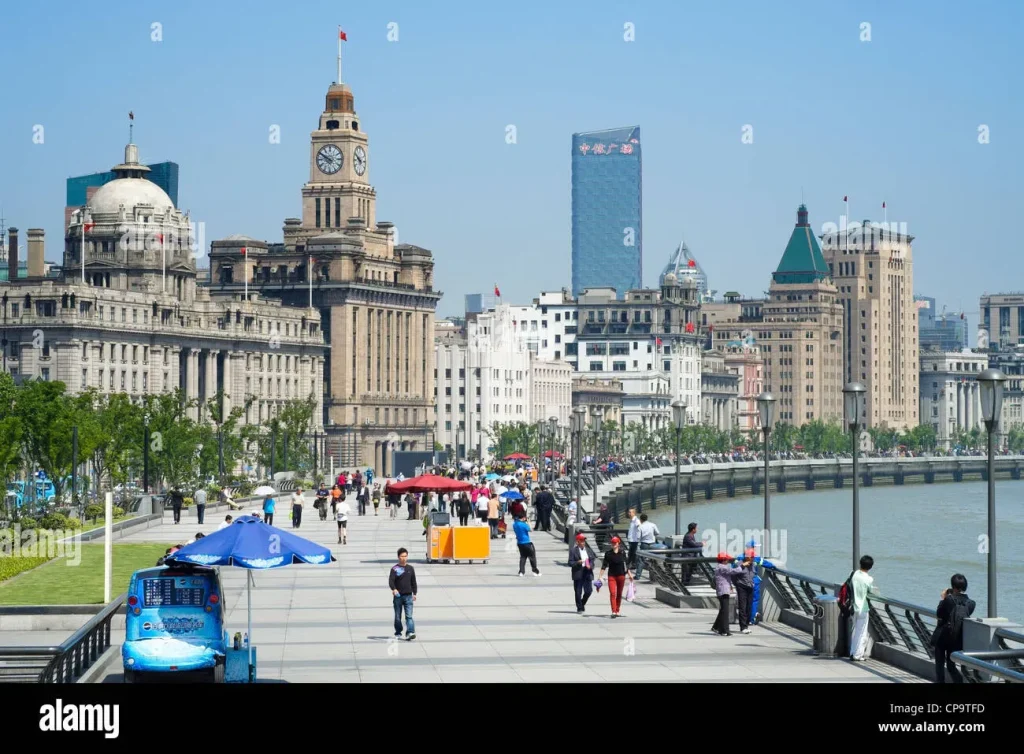The historic building in Shanghai, known as the Huayanli complex, is an extraordinary testament to innovative engineering and urban preservation. Recently, it made headlines as it was relocated 33 feet using 432 advanced engineering robots, showcasing the remarkable combination of heritage technology and modern design. Constructed between the 1920s and 1930s, this Shikumen-style structure weighs an impressive 7,500 metric tons and occupies a significant space in Shanghai’s vibrant Zhangyuan district. As the city plans to develop an extensive underground cultural and commercial hub, the careful relocation of this historic landmark underscores the balance between progress and preserving the past. This ambitious project not only aims to retain the integrity of the Huayanli complex but also to intertwine history with the future of urban development in Shanghai.
In the heart of Shanghai, an architectural marvel is reshaping the landscape: an iconic historic structure is on the move thanks to state-of-the-art robotics. The Huayanli complex, celebrated for its unique Shikumen architecture, is being temporarily shifted to accommodate modern advancements beneath it. This daring endeavor exemplifies urban renewal efforts that honor both the past and future, marrying cutting-edge technology with historical significance. As innovative engineers harness a fleet of small robots to ensure the careful relocation of this notable building, they pave the way for a new era in city planning that prioritizes heritage preservation while embracing modernization. The project stands as a beacon of how cities can grow without losing touch with their rich cultural tapestries.
The Significance of Shikumen Architecture in Shanghai
Shikumen architecture is not only a defining style of Shanghai’s urban landscape but also a unique cultural artifact that reflects the city’s rich history. This architectural style emerged in the 19th century, integrating Western building techniques with traditional Chinese designs. The result is a hybrid aesthetic that perfectly captures the spirit of Shanghai as a cosmopolitan city. The Huayanli complex is a prime example of this distinctive style, showcasing characteristics like slate roofs, elegant vertical wooden bars, and carved stone doorways, which offer insights into the life and culture of Shanghai during the early 20th century.
As Shanghai continues to develop aggressively, the preservation of Shikumen buildings becomes increasingly important. Urban preservation efforts not only safeguard these historic structures but also celebrate the city’s architectural diversity. By maintaining and relocating pieces like the Huayanli complex using advanced engineering, the city underscores its commitment to preserving heritage while accommodating modern growth. This balance is essential for keeping the identity of Shanghai intact as it evolves.
Moreover, the distinct Shikumen architecture draws both tourists and locals, further emphasizing the need for preservation amid urban expansion. Diversifying cultural heritage offers significant opportunities for enhancing the tourism sector in Shanghai, fostering a sense of pride among residents and reinforcing the historical narrative of the city.
Innovative Technology in Heritage Preservation
The use of advanced engineering techniques reflects a profound respect for heritage while simultaneously addressing modern urban challenges. In the case of the Huayanli complex, the strategic use of 432 robots in the relocation process showcases a remarkable intersection of heritage technology and urban development. Traditional means of relocating large structures would risk damaging significant architectural features; however, the precision of robotic technology allows for a meticulous approach to preserving the integrity of the historic buildings while facilitating urban progress.
In addition, the integration of building information modeling (BIM) and AI-based systems enables engineers to create highly accurate digital models that assist in relocating the Huayanli complex safely. This innovation not only ensures that the building is moved with minimal disruption but also safeguards the foundations for its eventual return. The application of technology in this manner highlights how cities like Shanghai can harness innovation to maintain their cultural heritage while adapting to the demands of contemporary urban life.
Urban Development Versus Historical Preservation
The ongoing development within Shanghai’s urban fabric often raises questions about the balance between modernization and historical preservation. The plan to construct a three-story underground center while the historic Huayanli complex remains above ground illustrates how cities can effectively integrate new infrastructure into existing historical contexts. By ensuring that important architectural landmarks are preserved, Linda Zhang, an urban planner in Shanghai, argues that cities can create spaces that are functional, innovative, and respectful of their past.
This dual approach of progress and preservation serves as a template for future urban planning in cities worldwide. It emphasizes that developments do not always have to come at the expense of historical integrity, but rather, the two can co-exist harmoniously. The Zhangyuan district’s proactive stance on reshaping its landscape while respecting its architectural heritage sets a significant precedent, showcasing that urban development can enrich the city’s cultural narrative rather than diminish it.
Challenges of Relocating Historic Structures
The relocation of the Huayanli complex represents a monumental challenge, particularly due to the dense nature of the Zhangyuan area, which is characterized by narrow alleyways and closely packed historic buildings. Any error during the moving process could result in irreparable damage to the delicate architecture, highlighting the critical nature of precision in the execution of this project. Navigating such tight spaces requires specialized equipment and techniques not typically used in traditional construction or relocation practices.
Moreover, the historical significance of the Huayanli complex adds an additional layer of responsibility to the project. As part of an area over 140 years old, any construction-related interruptions could affect not just the buildings themselves but also the local community’s heritage. Thus, ensuring that the project is carried out with the utmost care is essential for maintaining the rich historical tapestry of the Zhangyuan district.
The Future of Zhangyuan and Its Heritage
As the relocation of the Huayanli complex paves the way for modern amenities, the future of the Zhangyuan district looks promising. With a blend of cultural and commercial spaces designed to coexist with historically significant structures, this development aims to revitalize the area while retaining its unique character. The integration of modern infrastructure, such as the transportation hub that will connect major subway lines, into an area rich in history can foster vibrant community interactions.
This balancing act ensures that future generations can experience both the charm of historic landmarks and the comforts of modern urban living. The final vision for Zhangyuan will serve as a reminder of the city’s illustrious past while simultaneously advancing its future. By investing in cultural preservation, Shanghai exemplifies how urban spaces can evolve dynamically, embracing innovation without losing sight of their historical roots.
Robotic Technology: A New Era in Preservation
The deployment of 432 small robots in the relocation process signifies a revolutionary advancement in the field of construction and preservation. By employing cutting-edge robotics, engineers can orchestrate an intricate movement of massive structures like the Huayanli complex with unparalleled precision. These robots not only provide physical mobility but employ advanced AI systems to assess and navigate the complexities of the environment, ensuring that both the heritage structure and its surroundings are properly managed during the process.
The successful relocation of historic buildings like the Huayanli complex through robotic means marks a pivotal moment in urban planning. As cities face increased pressure to develop while preserving their historical identity, such innovative technologies present viable solutions. This technique could inspire similar projects globally, proving that respecting heritage and advancing urban landscapes not only is possible, but can thrive alongside one another.
Cultural Impact of the Huayanli Complex Relocation
The relocation of the historic Huayanli complex carries significant cultural implications for both the local community and the city of Shanghai. As an emblem of the Shikumen architectural style, the complex plays a vital role in narrating the history and identity of Shanghai. By ensuring its preservation through innovative methods, the project highlights the importance of cultural heritage in fast-paced urban environments and sets a precedent for future heritage preservation efforts.
Moreover, this project serves as an educational opportunity, allowing residents and visitors alike to engage with the history of Shanghai in a tangible way. The upcoming addition of modern amenities could serve as a platform for cultural exchange, creating spaces for exhibitions and events that celebrate local traditions and artistry. Ultimately, the impact of moving the Huayanli complex extends beyond physical preservation; it is about fostering a deeper appreciation for the cultural dialogues that give life to the city.
Balancing Modernity and Heritage in Urban Planning
In the midst of rapid urban growth, the balance between modernity and heritage becomes a pressing issue for cities like Shanghai. The Huayanli complex’s relocation is a beacon of hope, signaling that contemporary urban development can respect and preserve historical narratives. By creating a framework where modern infrastructure sits beneath or alongside historic sites, planners can cultivate environments that honor the past while also providing for the community’s future needs.
Implementing such harmonious designs reflects a shift in urban planning philosophies, where cultural appreciation and technological advances work hand in hand. Cities are more than just economic hubs; they are narratives of people, history, and progress. Emphasizing this narrative is crucial in fostering community pride and ensuring that urban expansion is not merely an enumeration of skyscrapers but a fabric woven with history, culture, and innovation.
The Journey of Shanghai’s Urban Evolution
The journey of Shanghai’s urban evolution is marked by a remarkable synthesis of heritage and innovation. From its beginnings as a small fishing village to becoming a global metropolis, the city has consistently adapted to the changing tides of history. Projects like the relocation of the Huayanli complex not only enhance the city’s functionality but also serve as poignant reminders of its cultural lineage. This evolution demonstrates that modernization does not necessitate the erasure of the past, but rather can be a collaborative force that enriches urban identity.
As Shanghai forges ahead, the lessons learned from projects such as the Huayanli relocation will influence how other cities approach urban development. The innovative melding of robots, advanced engineering, and historical preservation will inspire international dialogues on best practices in urban planning. By sharing these narratives, Shanghai can lead a movement toward developing cities that are both cutting-edge and steeped in cultural significance, truly embodying the spirit of a city in constant reinvention.
Frequently Asked Questions
What is the significance of the historic building moved by robots in Shanghai?
The historic building moved by robots in Shanghai, specifically the Huayanli complex, is significant as it exemplifies Shikumen architecture, a unique blend of Western and Chinese styles. The complex was built in the 1920s and 1930s and represents an important piece of Shanghai’s cultural heritage, reflecting the city’s architectural history while adapting to modern demands.
How does the relocation of a historic building in Shanghai reflect urban preservation efforts?
The successful relocation of the Huayanli complex in Shanghai showcases modern urban preservation strategies that allow for development while conserving historical sites. By using advanced engineering techniques such as robot relocation, Shanghai aims to protect its architectural heritage, demonstrating a commitment to preserving historical landmarks amid urban expansion.
What advanced engineering methods were used in the moving of the historic Huayanli building in Shanghai?
The moving of the historic Huayanli building in Shanghai employed advanced engineering methods, including the use of 432 small robots that carefully lifted and moved the structure incrementally. These robots utilized state-of-the-art technology such as building information modeling and AI-enabled earth-moving robots, ensuring precision in relocating a delicate heritage site while minimizing disruption.
Why is Shikumen architecture important to Shanghai’s heritage?
Shikumen architecture is vital to Shanghai’s heritage as it combines Western and Chinese design elements, symbolizing the cultural fusion present in the city during the late 19th and early 20th centuries. The preservation of structures like the Huayanli complex is essential to maintaining the historical identity of Shanghai and provides insight into the city’s urban development and cultural evolution.
What challenges are faced in relocating a historic building in Shanghai?
Relocating a historic building in Shanghai, such as the Huayanli complex, presents significant challenges including navigating narrow alleys and ensuring the integrity of surrounding historical structures. The density of the area requires careful planning and advanced techniques to avoid damaging irreplaceable architecture, emphasizing the importance of urban preservation in a bustling metropolis.
What is the future of urban development in Shanghai with regard to heritage technology and historic buildings?
The future of urban development in Shanghai signifies a growing integration of heritage technology with an emphasis on preserving historic buildings while accommodating modern infrastructure. Projects like the relocation of the Huayanli complex reflect a vision where urban preservation and innovative engineering coexist, allowing the city to evolve without compromising its rich cultural history.
How has the move of the Huayanli complex demonstrated the role of technology in historic preservation?
The move of the Huayanli complex in Shanghai illustrates the important role of technology in historic preservation by showing how innovative methods, such as robotics and AI, can effectively facilitate the safe relocation of heritage structures. This project highlights the potential for modern engineering to aid in the conservation of cultural landmarks amidst urban development.
| Key Points | Details |
|---|---|
| Historic Building in Shanghai | The Huayanli complex is a Shikumen-style building being relocated to facilitate underground development. |
| Engineering Feat | 432 robots are employed to move the 7,500 metric tons building 33 feet daily. |
| Preservation vs Development | The project aims to preserve the historical building while allowing for a modern transport hub and commercial space beneath. |
| Challenges | Narrow alleys and close proximity to other historic buildings make traditional methods impractical. |
| Technological Innovations | Special robotics and AI technologies are used to navigate and relocate the building accurately. |
| Future Vision | The revitalized area will blend historical architecture with modern urban development. |
Summary
The historic building in Shanghai, known as the Huayanli complex, represents a groundbreaking effort in urban preservation and innovation. By employing 432 robots to move this iconic structure, Shanghai is paving the way for modern developments while respecting its rich cultural heritage. The project not only highlights the potential of technology in preserving history but also sets a precedent for future urban planning, ensuring that the past and future can coexist harmoniously.



